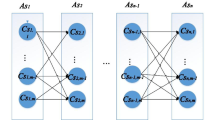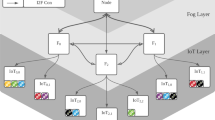Abstract
The primary goal of the Internet of things(IoT) is to provide people with anywhere services in real life. But intelligent IoT shouldn’t only provide services, but also consider how to allocate heterogeneous resources reasonably, which has become a very challenging problem. To obtain the best resource allocation scheme, it is crucial to minimize the service cost and service time. Since the two objectives are contradictory, we have modelled IoT services as a dynamic multi-objective optimization problem. Then a dynamic multi-objective evolutionary algorithm for dynamic IoT services(dMOEA/DI) is proposed. In dMOEA/DI, we have designed operators such as the appropriate encoding method, dynamic detection operator, filtering strategy, differential evolution, and polynomial mutation. Based on the single service strategy and collaborative service strategy, experimental research is performed on the agricultural IoT services with dynamic requests under different distributions. The simulation experimental results prove that dMOEA/DI performs better than the contrasted algorithms on the IoT service optimization problems.























Similar content being viewed by others
References
Li S, Zhang N, Lin S, Kong L, Katangur A, Khan MK, Ni M, Zhu G (2018) Joint admission control and resource allocation in edge computing for internet of things. IEEE Netw 32(1):72–79
Abuzainab N, Saad W, Hong CS, Poor HV (2017) Cognitive hierarchy theory for distributed resource allocation in the internet of things. IEEE Trans Wirel Commun 16(12):7687–7702
Tran-Dang H, Kim DS (2018) An information framework for internet of things services in physical internet. IEEE Access 6:43967–43977
Lin J, Yu W, Zhang N, Yang X, Zhang H, Zhao W (2017) A survey on internet of things: architecture, enabling technologies, security and privacy, and applications. IEEE Internet Things J 4(5):1125–1142
Servia-Rodríguez S, Rachuri K K, Mascolo C, et al. (2017) Mobile sensing at the service of mental well-being: a large-scale longitudinal study. Proceedings of the 26th international conference on world wide web 103-112
Bayhan S, Zubow A, Wolisz A (2018) Spass: Spectrum sensing as a service via smart contracts. IEEE International Symposium on Dynamic Spectrum Access Networks (DySPAN) 2018:1–10
Alsaryrah O, Mashal I, Chung T Y.(2018) Energy-aware services composition for internet of things. 2018 IEEE 4th world forum on internet of things (WF-IoT) 604-608
Alsaryrah O, Mashal I, Chung TY (2018) Bi-objective optimization for energy aware internet of things service composition. IEEE Access 6:26809–26819
Khanouche ME, Gadouche H, Farah Z, Tari A (2020) Flexible QoS-aware services composition for service computing environments. Comput Netw 166:106982
Prenkert F, Hasche N, Linton G (2019) Towards a systematic analytical framework of resource interfaces. J Bus Res 100:139–149
Nebro AJ, Ruiz AB, Barba-González C, García-Nieto J, Luque M, Aldana-Montes JF (2018) InDM2: interactive dynamic multi-objective decision making using evolutionary algorithms. Swarm and Evolutionary Computation 40:184–195
Orouskhani M, Teshnehlab M, Nekoui MA (2019) Evolutionary dynamic multi-objective optimization algorithm based on Borda count method. Int J Mach Learn Cybern 10(8):1931–1959
Chowdhury A, Raut SA (2018) A survey study on internet of things resource management. J Netw Comput Appl 120:42–60
Wan J, Chen B, Imran M, Tao F, Li D, Liu C, Ahmad S (2018) Toward dynamic resources management for IoT-based manufacturing. IEEE Commun Mag 56(2):52–59
Zhang Y, Liu S, Liu Y, Yang H, Li M, Huisingh D, Wang L (2018) The ‘internet of things’ enabled real-time scheduling for remanufacturing of automobile engines. J Clean Prod 185:562–575
Wu D, Zhang Z, Wu S et al (2018) Biologically inspired resource allocation for network slices in 5G-enabled internet of things. IEEE Internet Things J 6(6):9266–9279
Li G, Wu J, Li J, Wang K, Ye T (2018) Service popularity-based smart resources partitioning for fog computing-enabled industrial internet of things. IEEE Transactions on Industrial Informatics 14(10):4702–4711
Hussein D, Han SN, Lee GM, Crespi N, Bertin E (2017) Towards a dynamic discovery of smart services in the social internet of things. Computers & Electrical Engineering 58:429–443
Qiu T, Zheng K, Han M et al (2017) A data-emergency-aware scheduling scheme for internet of things in smart cities. IEEE Transactions on Industrial Informatics 14(5):2042–2051
Tang C, Wei X, Xiao S, Chen W, Fang W, Zhang W, Hao M (2018) A mobile cloud based scheduling strategy for industrial internet of things. IEEE Access 6:7262–7275
Guo YN, Cheng J, Luo S, Gong D, Xue Y (2017) Robust dynamic multi-objective vehicle routing optimization method. IEEE/ACM transactions on computational biology and bioinformatics 15(6):1891–1903
Jiang Y, Hao K, Cai X, et al.(2018) Optimal schedule for agricultural machinery in sequential tasks using a multi-population co-evolutionary non-dominant neighbor immune algorithm. 2018 37th Chinese control conference (CCC) 2259-2264
El-Shorbagy MA, Elhoseny M, Hassanien AE et al (2019) A novel PSO algorithm for dynamic wireless sensor network multiobjective optimization problem. Trans Emerg Telecommun Technol 30(11):e3523
Lu C, Gao L, Li X, Xiao S (2017) A hybrid multi-objective grey wolf optimizer for dynamic scheduling in a real-world welding industry. Eng Appl Artif Intell 57:61–79
Tseng FH, Wang X, Chou LD et al (2017) Dynamic resource prediction and allocation for cloud data center using the multiobjective genetic algorithm. IEEE Syst J 12(2):1688–1699
Eaton J, Yang S, Gongora M (2017) Ant colony optimization for simulated dynamic multi-objective railway junction rescheduling. IEEE Trans Intell Transp Syst 18(11):2980–2992
Chaudhry R, Tapaswi S, Kumar N (2019) FZ enabled multi-objective PSO for multicasting in IoT based wireless sensor networks. Inf Sci 498:1–20
Guo YN, Zhang X, Gong DW, Zhang Z, Yang JJ (2019) Novel interactive preference-based multi-objective evolutionary optimization for bolt supporting networks. IEEE Trans Evol Comput 24:750–764. https://doi.org/10.1109/TEVC.2019.2951217
Han J, Yang C, Zhou X, Gui W (2017) Dynamic multi-objective optimization arising in iron precipitation of zinc hydrometallurgy. Hydrometallurgy 173:134–148
Gong D, Xu B, Zhang Y, Guo Y, Yang S (2020) A similarity-based cooperative co-evolutionary algorithm for dynamic interval multi-objective optimization problems. IEEE Trans Evol Comput 24(1):142–156
Yang Z, Jin Y, Hao K (2018) A bio-inspired self-learning coevolutionary dynamic multiobjective optimization algorithm for internet of things services. IEEE Trans Evol Comput 23(4):675–688
Azzouz R, Bechikh S, Said LB (2017) Dynamic multi-objective optimization using evolutionary algorithms: a survey. Recent advances in evolutionary multi-objective optimization:31–70
Zhang J, Xing L. (2017) A survey of multiobjective evolutionary algorithms. 2017 IEEE international conference on computational science and engineering (CSE) and IEEE international conference on embedded and ubiquitous computing (EUC) 1: 93-100
Srinivas N, Deb K (1994) Muiltiobjective optimization using nondominated sorting in genetic algorithms. Evol Comput 2(3):221–248
Jiang S, Yang S (2017) A strength Pareto evolutionary algorithm based on reference direction for multiobjective and many-objective optimization. IEEE Trans Evol Comput 21(3):329–346
Murata T, Ishibuchi H (1995) MOGA: multi-objective genetic algorithms. IEEE international conference on evolutionary computation 1:289–294
Day R O, Lamont G B. (2005) Extended multi-objective fast messy genetic algorithm solving deception problems. International conference on evolutionary multi-criterion optimization 296-310
Horn J, Nafpliotis N, Goldberg D E.(1994) A niched Pareto genetic algorithm for multiobjective optimization.Proceedings of the first IEEE conference on evolutionary computation. IEEE world congress on computational intelligence 82-87
Zitzler E, Laumanns M, Thiele L.(2001) SPEA2: improving the strength Pareto evolutionary algorithm. TIK-report 103
Deb K, Pratap A, Agarwal S, Meyarivan T (2002) A fast and elitist multiobjective genetic algorithm: NSGA-II. IEEE Trans Evol Comput 6(2):182–197
Rudzinski F (2015) Finding sets of non-dominated solutions with high spread and well-balanced distribution using generalized strength Pareto evolutionary algorithm. 2015 Conference of the international fuzzy systems association and the European Society for Fuzzy Logic and Technology (IFSA-EUSFLAT-15). Atlantis Press. https://doi.org/10.2991/ifsa-eusflat-15.2015.28
Deb K, Jain H (2013) An evolutionary many-objective optimization algorithm using reference-point-based nondominated sorting approach, part I: solving problems with box constraints. IEEE Trans Evol Comput 18(4):577–601
Tan KC, Goh CK, Mamun AA, Ei EZ (2008) An evolutionary artificial immune system for multi-objective optimization. Eur J Oper Res 187(2):371–392
Gong M, Jiao L, Du H et al (2008) Multiobjective immune algorithm with nondominated neighbor-based selection. Evolutionary Computation 16(2):225–255
Lin Q, Ma Y, Chen J et al (2018) An adaptive immune-inspired multi-objective algorithm with multiple differential evolution strategies. Inf Sci 430:46–64
Lin Q, Zhu Q, Wang N, Huang P, Wang W, Chen J, Ming Z (2019) A multi-objective immune algorithm with dynamic population strategy. Swarm and Evolutionary Computation 50:100477
Mirjalili S, Saremi S, Mirjalili SM (2016) Multi-objective grey wolf optimizer: a novel algorithm for multi-criterion optimization. Expert Syst Appl 47:106–119
Xu X, Tan Y, Zheng W, Li S (2018) Memory-enhanced dynamic multi-objective evolutionary algorithm based on Lp decomposition. Appl Sci 8(9):1673
Rong M, Gong D, Zhang Y, Pedrycz W (2019) Multidirectional prediction approach for dynamic multiobjective optimization problems. IEEE Transactions on Cybernetics 49(9):3362–3374
Rong M, Gong D, Pedrycz W, Wang L (2020) A multimodel prediction method for dynamic multiobjective evolutionary optimization. IEEE Trans Evol Comput 24(2):290–304
Guo Y, Yang H, Chen M, Cheng J, Gong D (2019) Ensemble prediction-based dynamic robust multi-objective optimization methods. Swarm and Evolutionary Computation 48:156–171
Martinez SZ, Coello CAC (2014) A multi-objective evolutionary algorithm based on decomposition for constrained multi-objective optimization. IEEE Congress on evolutionary computation (CEC) 2014:429–436
Lin S, Lin F, Chen H, Zeng W (2017) A MOEA/D-based multi-objective optimization algorithm for remote medical. Neurocomputing 220:5–16
Zhou Y, Liu J, Zhang Y, Gan X (2017) A multi-objective evolutionary algorithm for multi-period dynamic emergency resource scheduling problems. Transportation Research Part E: Logistics and Transportation Review 99:77–95
Muruganantham A. (2017) Dynamic multiobjective optimization using evolutionary algorithms. Dissertation, National University of Singapore
Xu X, Tan Y, Zheng W, Li S (2018) Memory-enhanced dynamic multi-objective evolutionary algorithm based on Lp decomposition. Appl Sci 8(9):1673
Zhang Q, Liu W, Li H (2009) The performance of a new version of MOEA/D on CEC09 unconstrained MOP test instances. IEEE congress on evolutionary computation 2009:203–208
Muangprathub J, Boonnam N, Kajornkasirat S, Lekbangpong N, Wanichsombat A, Nillaor P (2019) IoT and agriculture data analysis for smart farm. Comput Electron Agric 156:467–474
Ma X, Zhang Q, Tian G et al (2017) On Tchebycheff decomposition approaches for multiobjective evolutionary optimization. IEEE Trans Evol Comput 22(2):226–244
Wu G, Shen X, Li H, Chen H, Lin A, Suganthan PN (2018) Ensemble of differential evolution variants. Inf Sci 423:172–186
Cambra C, Sendra S, Lloret J, et al. (2017) An IoT service-oriented system for agriculture monitoring. 2017 IEEE International Conference on Communications (ICC) 1–6
Zhu Q, Zhu Z, Qi Y, Yu H, Xu Y (2018) Optimization of cascading failure on complex network based on NNIA. Physica A: Statistical Mechanics and its Applications 501:42–51
Lin YH, Huang LC, Chen SY, Yu CM (2018) The optimal route planning for inspection task of autonomous underwater vehicle composed of MOPSO-based dynamic routing algorithm in currents. Appl Ocean Res 75:178–192
Wang H, Deutz A, Back T, et al.(2017) Hypervolume indicator gradient ascent multi-objective optimization. International conference on evolutionary multi-criterion optimization 654-669
Acknowledgements
This work was supported by the National Natural Science Foundation of China (Grant nos. 61972456,41772123); Natural Science Foundation of Tianjin (No. 19JCYBJC15800).
Author information
Authors and Affiliations
Corresponding author
Additional information
Publisher’s note
Springer Nature remains neutral with regard to jurisdictional claims in published maps and institutional affiliations.
Rights and permissions
About this article
Cite this article
Fang, Ss., Chai, Zy. & Li, Yl. Dynamic multi-objective evolutionary algorithm for IoT services. Appl Intell 51, 1177–1200 (2021). https://doi.org/10.1007/s10489-020-01861-7
Published:
Issue Date:
DOI: https://doi.org/10.1007/s10489-020-01861-7




